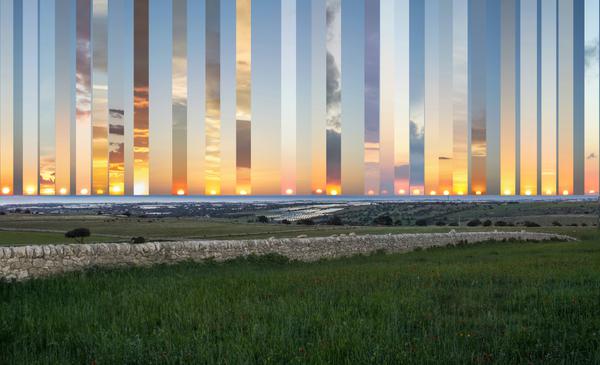This page describes an image Occasive Amplitude
Image caption:
Captured from Gatto Corvino village in Sicily, this composite showcases the Sun setting at various points over the sea from the winter to the summer solstice (2016–2017). The centre frame marks due west. As Earth orbits the Sun, the position of the setting (and rising) Sun changes from being northward of due west (east) in summer to southward of due west (east) in winter. During the equinoxes — when day and night are of equal length — the Sun rises directly in the east and sets directly in the west. The changing location of the Sun on the horizon is due to Earth’s axial tilt as it orbits the Sun. In temperate regions of Earth, the Sun’s height above the horizon at noon is at its highest and lowest points in the sky on the summer and winter solstices respectively.
Scroll to captions in other languages
Image credit:
Marcella Giulia Pace/IAU OAE (CC BY 4.0)
DOI: 10.5281/zenodo.10278776
Tags:
astrophotography
Related glossary terms:
Equinox
, Solstice
, Summer Solstice
, Sun Path (Day Arc)
, Winter Solstice
Categories:
Naked Eye Astronomy
Image license: Creative Commons Attribution 4.0 International (CC BY 4.0) Creative Commons Attribution 4.0 International (CC BY 4.0) icons
The media file captions presented on the OAE website were written, translated and reviewed by a collective effort from the OAE, the OAE Centers and Nodes, the OAE National Astronomy Education Coordinators (NAECs) and other volunteers. You can find a full list of credits for our translation project here. All media file captions are released under a Creative Commons CC BY-4.0 license and should be credited to "IAU OAE". The media files themselves may have different licenses (see above) and should be credited as listed above under "credit".
If you notice a factual error in this caption or an error in any of its translations then please get in touch.
Captions in Different Languages:
Image caption: সিসিলির গাট্টো করভিনো গ্রাম থেকে ধারণ করা, এই সংমিশ্রণটি শীত থেকে গ্রীষ্মের অয়নকাল (২০১৬-২০১৭) পর্যন্ত সমুদ্রের উপর বিভিন্ন পয়েন্টে সূর্যাস্ত দেখায়। কেন্দ্রের ফ্রেম পশ্চিমের কারণে চিহ্নিত। পৃথিবী যখন সূর্যকে প্রদক্ষিণ করে, তখন সূর্যের অস্তগামী (এবং উদীয়মান) অবস্থান গ্রীষ্মকালে পশ্চিমের (পূর্ব) উত্তর দিকে থেকে শীতকালে পশ্চিমের দক্ষিণ দিকে (পূর্ব দিকে) পরিবর্তিত হয়। বিষুবকালে - যখন দিন এবং রাত সমান দৈর্ঘ্যের হয় - সূর্য সরাসরি পূর্বে উদিত হয় এবং সরাসরি পশ্চিমে অস্ত যায়। দিগন্তে সূর্যের পরিবর্তিত অবস্থান পৃথিবীর অক্ষীয় কাত হওয়ার কারণে এটি সূর্যকে প্রদক্ষিণ করে। পৃথিবীর নাতিশীতোষ্ণ অঞ্চলে, সূর্যের উচ্চতা দিগন্তের উপরে থাকে যথাক্রমে গ্রীষ্ম ও শীতকালে আকাশের সর্বোচ্চ এবং সর্বনিম্ন বিন্দুতে।
Image credit: মার্সেলা গিউলিয়া পেস/আইএইউ ওএই (CC BY 4.0)
Related glossary terms: Equinox , Solstice , Summer Solstice , Sun Path (Day Arc) , Winter Solstice Caption translation status: Not yet approved by a reviewer
Caption translators: Raktim Mukherjee
Image caption: Secondo posto al concorso di astrofotografia IAU OAE 2023, categoria Immagini fisse di luoghi all'alba e tramonto nel corso dell'anno: Ampiezza occasiva, di Marcella Giulia Pace.
Ripreso dal villaggio di Gatto Corvino in Sicilia, questa composizione mostra il Sole che tramonta in vari punti sul mare dal solstizio d'inverno a quello d'estate (2016-2017). Si è aggiudicato il secondo posto nella categoria Immagini fisse di alba e tramonto nel corso dell'anno. Il riquadro centrale segna la direzione ovest. Quando la Terra orbita intorno al Sole, la posizione del Sole che tramonta (e che sorge) cambia verso nord rispetto a ovest (est) in estate verso sud rispetto a ovest (est) in inverno. Durante gli equinozi - quando il giorno e la notte hanno la stessa durata - il Sole sorge direttamente a est e tramonta direttamente a ovest. La variazione della posizione del Sole sull'orizzonte è dovuta all'inclinazione assiale della Terra durante la sua orbita intorno al Sole. Nelle regioni temperate della Terra, l'altezza del Sole sopra l'orizzonte a mezzogiorno è al suo punto più alto e più basso nel cielo rispettivamente al solstizio d'estate e al solstizio d'inverno.
Image credit: Marcella Giulia Pace/IAU OAE (CC BY 4.0)
Related glossary terms: Equinozio , Percorso del sole (arco diurno) , Solstizio , Solstizio d'estate , Solstizio d'inverno Caption translation status: Not yet approved by a reviewer
Caption translators: Valentina La Parola
Image caption: 这张合成照片拍摄于意大利西西里岛的 Gatto Corvino 村,展示了从2016年到2017年冬至到夏至期间,太阳在海面上不同位置的落日景象。中心框为正西方。随着地球绕太阳公转,太阳的落下(和升起)位置从夏季的正西(东)方向偏北,变化到冬季的正西(东)方向偏南。在春分和秋分时,白昼和黑夜的长度相等,太阳从正东方升起,正西方落下。太阳在地平线上位置的变化是由于地球绕太阳运行时的自转轴倾斜。在地球的温带地区,夏至和冬至时,正午太阳在地平线上的高度角分别达到最高和最低值。
Image credit: Marcella Giulia Pace/IAU OAE (CC BY 4.0)
Related glossary terms: 二至点 , 冬至 , 夏至 , 太阳路径(日弧) , 昼夜平分点 Caption translation status: Not yet approved by a reviewer
Caption translators: Xiao Jingyu
Caption reviewers: Wang Yilin
Image caption: 這張合成照片拍攝于意大利西西里島的 Gatto Corvino 村,展示了從2016年到2017年冬至到夏至期間,太陽在海面上不同位置的落日景象。中心框為正西方。隨著地球繞太陽公轉,太陽的落下(和升起)位置從夏季的正西(東)方向偏北,變化到冬季的正西(東)方向偏南。在春分和秋分時,白晝和黑夜的長度相等,太陽從正東方升起,正西方落下。太陽在地平線上位置的變化是由於地球繞太陽運行時的自轉軸傾斜。在地球的溫帶地區,夏至和冬至時,正午太陽在地平線上的高度角分別達到最高和最低值。
Image credit: Marcella Giulia Pace/IAU OAE (CC BY 4.0)
Related glossary terms: 二至點 , 冬至 , 夏至 , 太陽路徑(日弧) , 晝夜平分點 Caption translation status: Not yet approved by a reviewer
Caption translators: An automated transliteration from the simplified Chinese translation by - Xiao Jingyu









